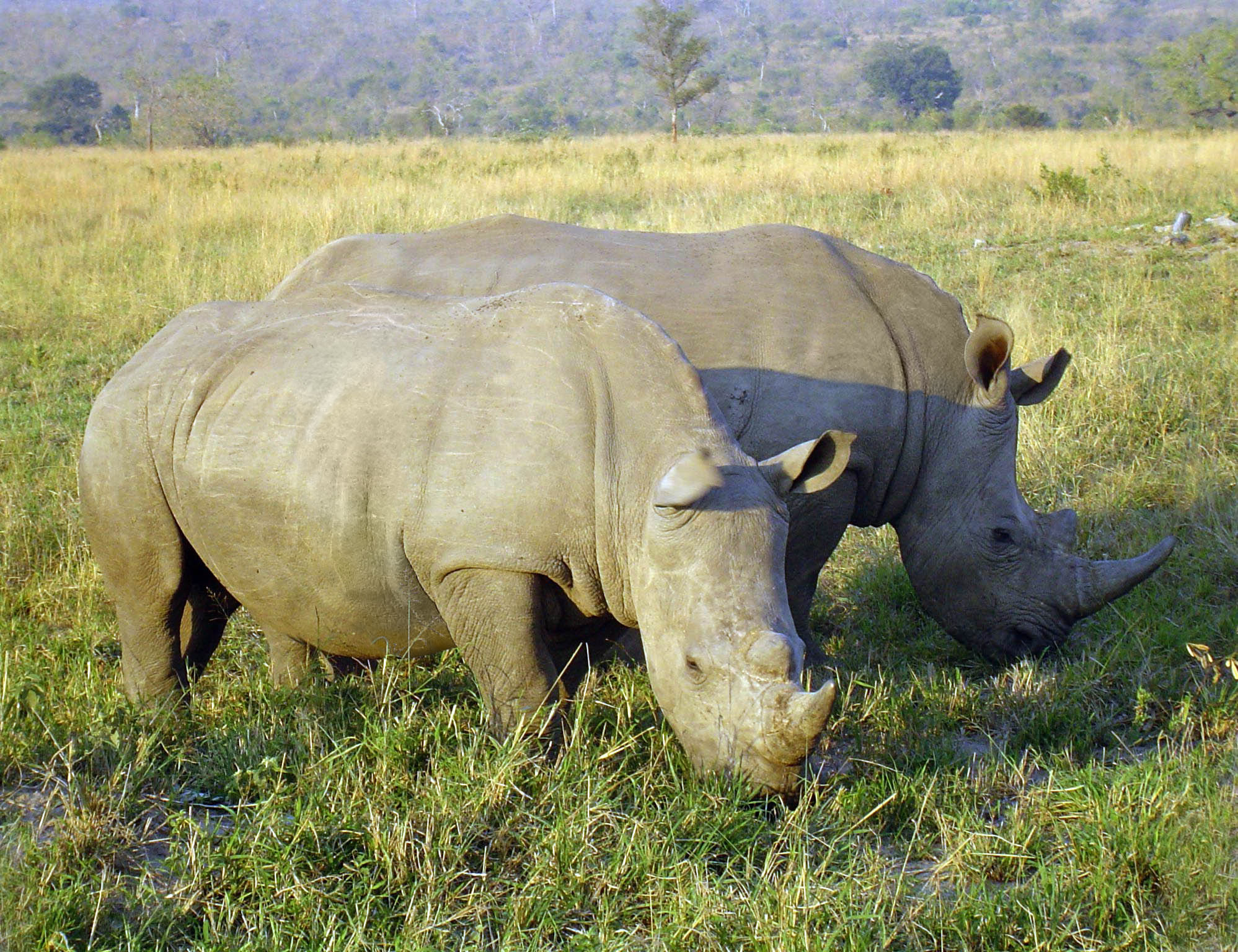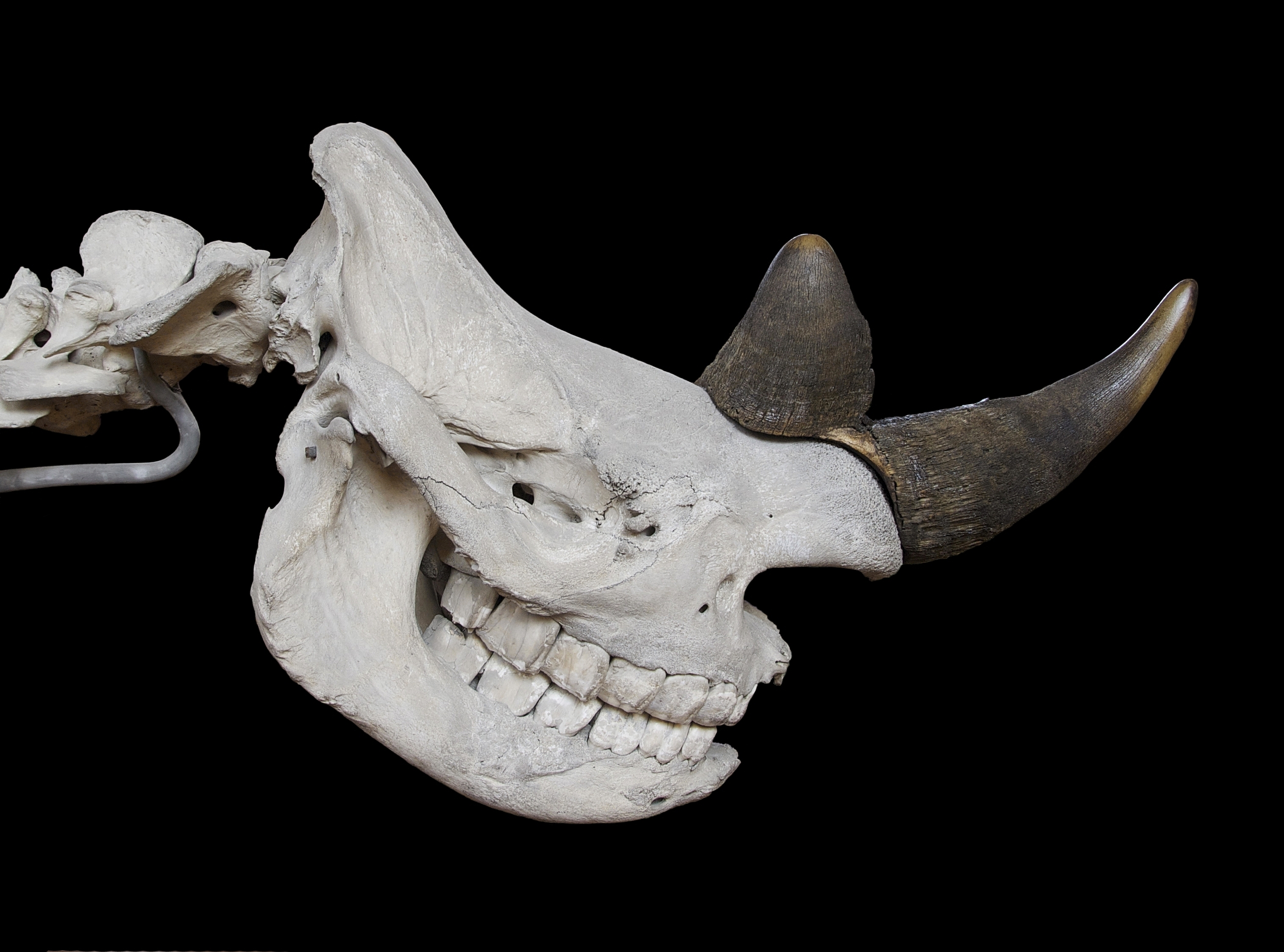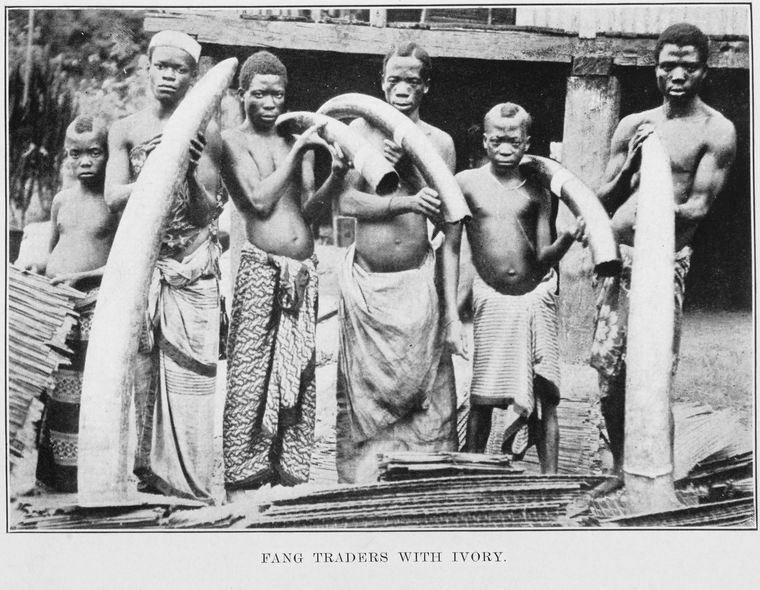|
Dicerotini
A rhinoceros ( ; ; ; : rhinoceros or rhinoceroses), commonly abbreviated to rhino, is a member of any of the five extant species (or numerous extinct species) of odd-toed ungulates (perissodactyls) in the family Rhinocerotidae; it can also refer to a member of any of the extinct species of the superfamily Rhinocerotoidea. Two of the extant species are native to Africa, and three to South and Southeast Asia. Rhinoceroses are some of the largest remaining megafauna: all weigh over half a tonne in adulthood. They have a herbivorous diet, small brains for mammals of their size, one or two horns, and a thick , protective skin formed from layers of collagen positioned in a lattice structure. They generally eat leafy material, although their ability to ferment food in their hindgut allows them to subsist on more fibrous plant matter when necessary. Unlike other perissodactyls, the two African species of rhinoceros lack teeth at the front of their mouths; they rely instead on their l ... [...More Info...] [...Related Items...] OR: [Wikipedia] [Google] [Baidu] |
Diceros
''Diceros'' (Greek: "two" (dio), "horn" (keratos)) is a genus of rhinoceros containing the extant black rhinoceros ''(Diceros bicornis)'' and several extinct species. Taxonomy ''Diceros'' is more closely related to the genus ''Ceratotherium'' (which contains the white rhinoceros) than it is to other living rhinoceroses, with the clade containing the two comprising the tribe Dicerotini (also spelled Diceroti) or subtribe Dicerotina. ''Diceros'' has been suggested by some authors to have branched off from an early species of ''Ceratotherium'', specifically '' C. neumayri,'' which has also been assigned to ''Diceros'' in some studies. However, other authors have disputed the close relationship between ''Diceros'' and ''"C". neumayri.'' The oldest species assigned to the genus is "''Diceros" australis'' from the Early Miocene of Namibia, dating to around 17-18 million years ago. It is only known from fragmentary remains, and its assignment to the genus, and even to Dicerotini have ... [...More Info...] [...Related Items...] OR: [Wikipedia] [Google] [Baidu] |
Ceratotherium
''Ceratotherium'' (from Greek: ''keras'' κέρας "horn" and ''thērion'' θηρίον "beast") is a genus within the family Rhinocerotidae. It comprises one living species, the white rhinoceros (''Ceratotherium simum''), and several extinct fossil species that trace its evolutionary lineage. Taxonomy and evolution The genus ''Ceratotherium'' belongs to the tribe Dicerotini (also spelled Diceroti) or subtribe Dicerotina, indicating a closer evolutionary relationship to the genus '' Diceros'' (which includes the black rhinoceros) than to other extant rhinoceros genera. The evolutionary history of ''Ceratotherium'' includes several recognized and debated fossil species: * '' Ceratotherium mauritanicum'': An extinct species known from the Pleistocene of North Africa. Some Pliocene East African remains, alternatively attributed by some authors to ''Ceratotherium efficax'', are sometimes included in ''C. mauritanicum''. Depending on the inclusion of these East African materials, ' ... [...More Info...] [...Related Items...] OR: [Wikipedia] [Google] [Baidu] |
White Rhinoceros
The white rhinoceros, also known as the white rhino or square-lipped rhinoceros (''Ceratotherium simum''), is the largest extant species of rhinoceros and the most Sociality, social of all rhino species, characterized by its wide mouth adapted for grazing (behaviour), grazing. The species includes two subspecies with dramatically different conservation outlooks: the southern white rhinoceros, with an estimated 17,464 individuals in the wild as of the end of 2023, and the northern white rhinoceros. The northern subspecies is critically endangered and on the brink of extinction; its last known male, Sudan (rhinoceros), Sudan, died in March 2018, leaving behind only a very small number of females in captivity. Both subspecies have faced significant threats, primarily from poaching for their horns and habitat loss, which contribute to the species' overall Conservation status, conservation status of Near Threatened. Naming One popular, though widely discredited, theory for the origi ... [...More Info...] [...Related Items...] OR: [Wikipedia] [Google] [Baidu] |
Black Rhinoceros
The black rhinoceros (''Diceros bicornis''), also called the black rhino or the hooked-lip rhinoceros, is a species of rhinoceros native to East Africa, East and Southern Africa, including Angola, Botswana, Eswatini, Kenya, Lesotho, Malawi, Mozambique, Namibia, South Africa, Tanzania, Zambia, and Zimbabwe. Although the species is referred to as ''black'', its colours vary from brown to grey. It is the only extant species of the genus ''Diceros''. The other rhinoceros native to Africa is the white rhinoceros (''Ceratotherium simum''). The word "white" in the name "white rhinoceros" is often said to be a misinterpretation of the Afrikaans word ' (Dutch language, Dutch ') meaning wide, referring to its square upper lip, as opposed to the pointed or hooked lip of the black rhinoceros. These species are now sometimes referred to as the square-lipped (for white) or hook-lipped (for black) rhinoceros. The species overall is classified as critically endangered (even though the south-wes ... [...More Info...] [...Related Items...] OR: [Wikipedia] [Google] [Baidu] |
Vietnam
Vietnam, officially the Socialist Republic of Vietnam (SRV), is a country at the eastern edge of mainland Southeast Asia, with an area of about and a population of over 100 million, making it the world's List of countries and dependencies by population, fifteenth-most populous country. One of two communist states in Southeast Asia, Vietnam shares land borders with China to the north, and Laos and Cambodia to the west. It shares Maritime boundary, maritime borders with Thailand through the Gulf of Thailand, and the Philippines, Indonesia, and Malaysia through the South China Sea. Its capital is Hanoi and its largest city is Ho Chi Minh City. Vietnam was inhabited by the Paleolithic age, with states established in the first millennium BC on the Red River Delta in modern-day northern Vietnam. Before the Han dynasty's invasion, Vietnam was marked by a vibrant mix of religion, culture, and social norms. The Han dynasty annexed Northern and Central Vietnam, which were subs ... [...More Info...] [...Related Items...] OR: [Wikipedia] [Google] [Baidu] |
China
China, officially the People's Republic of China (PRC), is a country in East Asia. With population of China, a population exceeding 1.4 billion, it is the list of countries by population (United Nations), second-most populous country after India, representing 17.4% of the world population. China spans the equivalent of five time zones and Borders of China, borders fourteen countries by land across an area of nearly , making it the list of countries and dependencies by area, third-largest country by land area. The country is divided into 33 Province-level divisions of China, province-level divisions: 22 provinces of China, provinces, 5 autonomous regions of China, autonomous regions, 4 direct-administered municipalities of China, municipalities, and 2 semi-autonomous special administrative regions. Beijing is the country's capital, while Shanghai is List of cities in China by population, its most populous city by urban area and largest financial center. Considered one of six ... [...More Info...] [...Related Items...] OR: [Wikipedia] [Google] [Baidu] |
Traditional Chinese Medicine
Traditional Chinese medicine (TCM) is an alternative medicine, alternative medical practice drawn from traditional medicine in China. A large share of its claims are pseudoscientific, with the majority of treatments having no robust evidence of effectiveness or logical mechanism of action. Some TCM ingredients Traditional Chinese medicine#Safety, are known to be toxic and cause disease, including cancer. Medicine in traditional China encompassed a range of sometimes competing health and healing practices, folk beliefs, Scholar-official, literati theory and Confucianism, Confucian philosophy, Chinese herbology, herbal remedies, Chinese food therapy, food, diet, exercise, medical specializations, and schools of thought. TCM as it exists today has been described as a largely 20th century invention. In the early twentieth century, Chinese cultural and political modernizers worked to eliminate traditional practices as backward and unscientific. Traditional practitioners then selec ... [...More Info...] [...Related Items...] OR: [Wikipedia] [Google] [Baidu] |
Black Market
A black market is a Secrecy, clandestine Market (economics), market or series of transactions that has some aspect of illegality, or is not compliant with an institutional set of rules. If the rule defines the set of goods and services whose production and distribution are prohibited or restricted by law, non-compliance with the rule constitutes a black-market trade since the transaction itself is illegal. Such transactions include the illegal drug trade, prostitution (where prohibited), illegal currency transactions, and human trafficking. Participants try to hide their illegal behavior from the government or regulatory authority. Cash is the preferred medium of exchange in illegal transactions, since cash transactions are less easily traced. Common motives for operating in black markets are to trade contraband, avoid taxes and regulations, or evade price controls or rationing. Typically, the totality of such activity is referred to with the definite article, e.g., "''the' ... [...More Info...] [...Related Items...] OR: [Wikipedia] [Google] [Baidu] |
Southeast Asia
Southeast Asia is the geographical United Nations geoscheme for Asia#South-eastern Asia, southeastern region of Asia, consisting of the regions that are situated south of China, east of the Indian subcontinent, and northwest of the Mainland Australia, Australian mainland, which is part of Oceania. Southeast Asia is bordered to the north by East Asia, to the west by South Asia and the Bay of Bengal, to the east by Oceania and the Pacific Ocean, and to the south by Australia (continent), Australia and the Indian Ocean. Apart from the British Indian Ocean Territory and two out of Atolls of the Maldives, 26 atolls of the Maldives in South Asia, Maritime Southeast Asia is the only other subregion of Asia that lies partly within the Southern Hemisphere. Mainland Southeast Asia is entirely in the Northern Hemisphere. Timor-Leste and the southern portion of Indonesia are the parts of Southeast Asia that lie south of the equator. The region lies near the intersection of Plate tectonics, ... [...More Info...] [...Related Items...] OR: [Wikipedia] [Google] [Baidu] |
Ivory Trade
The ivory trade is the commercial, often illegal trade in the ivory tusks of the hippopotamus, walrus, narwhal, black and white rhinos, mammoth, and most commonly, African elephant, African and Asian elephants. Ivory has been traded for hundreds of years by people in Africa and Asia, resulting in restrictions and bans. Ivory was formerly used to make piano keys and other decorative items because of the white color it presents when processed but the piano industry abandoned ivory as a key covering material in the 1980s in favor of other materials such as plastic. Also, synthetic ivory has been developed which can be used as an alternative material for making piano keys. Elephant ivory Elephant ivory has been exported from Africa and Asia for millennia with records going back to the 14th century Common Era, BCE. Transport of the heavy commodity was always difficult, and with the establishment of the early-modern slave trades from East and West Africa, freshly captured Slavery, ... [...More Info...] [...Related Items...] OR: [Wikipedia] [Google] [Baidu] |
Perissodactyl
Perissodactyla (, ), or odd-toed ungulates, is an order of Ungulate, ungulates. The order includes about 17 living species divided into three Family (biology), families: Equidae (wild horse, horses, Asinus, asses, and zebras), Rhinocerotidae (rhinoceroses), and Tapiridae (tapirs). They typically have reduced the weight-bearing toes to three or one of the five original toes, though tapirs retain four toes on their front feet. The nonweight-bearing toes are either present, absent, Vestigiality, vestigial, or positioned posteriorly. By contrast, Artiodactyl, artiodactyls (even-toed ungulates) bear most of their weight equally on four or two (an even number) of the five toes: their third and fourth toes. Another difference between the two is that perissodactyls digest plant cellulose in their intestines, rather than in one or more stomach chambers as artiodactyls, with the exception of Suina, do. The order was considerably more diverse in the past, with notable extinct groups inclu ... [...More Info...] [...Related Items...] OR: [Wikipedia] [Google] [Baidu] |
Colon (anatomy)
The large intestine, also known as the large bowel, is the last part of the gastrointestinal tract and of the digestive system in tetrapods. Water is absorbed here and the remaining waste material is stored in the rectum as feces before being removed by defecation. The colon (progressing from the ascending colon to the transverse, the descending and finally the sigmoid colon) is the longest portion of the large intestine, and the terms "large intestine" and "colon" are often used interchangeably, but most sources define the large intestine as the combination of the cecum, colon, rectum, and anal canal. Some other sources exclude the anal canal. In humans, the large intestine begins in the right iliac region of the pelvis, just at or below the waist, where it is joined to the end of the small intestine at the cecum, via the ileocecal valve. It then continues as the colon ascending the abdomen, across the width of the abdominal cavity as the transverse colon, and then desce ... [...More Info...] [...Related Items...] OR: [Wikipedia] [Google] [Baidu] |








